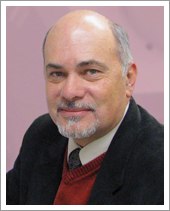Artificial Biofilms for Sanitary/Hygienic Interface Technologies
 Plamen Atanassov graduated from the University of Sofia (1987) specializing in Chemical Physics and Theoretical Chemistry. He joined the Bulgarian Academy of Sciences and became a Member of Technical Staff of its Central Laboratory of Electrochemical Power Sources (now the Institute for Electrochemistry & Power Systems). His initial work included materials solutions for metal-air batteries. He was a visiting scientist at the Frumkin’s Institute of Electrochemistry, Moscow, Russia studying bio-electrochemistry of enzymes and received a PhD in Physical Chemistry/Electrochemistry.
Plamen Atanassov graduated from the University of Sofia (1987) specializing in Chemical Physics and Theoretical Chemistry. He joined the Bulgarian Academy of Sciences and became a Member of Technical Staff of its Central Laboratory of Electrochemical Power Sources (now the Institute for Electrochemistry & Power Systems). His initial work included materials solutions for metal-air batteries. He was a visiting scientist at the Frumkin’s Institute of Electrochemistry, Moscow, Russia studying bio-electrochemistry of enzymes and received a PhD in Physical Chemistry/Electrochemistry.
Plamen Atanassov is a Distinguished Professor of Chemical & Biological Engineering at the University of New Mexico. He is the director of the UNM Center for Micro-Engineered Materials.
Dr. Atanassov’s research programs are focused on development of novel electrocatalysts: non-platinum electrocatalyst for fuel cells, nano-structured catalysts for oxidation of complex fuels, and new materials and technologies for energy conversion and storage. Dr. Atanassov’s bio-electrocatalysis programs range from enzyme electrochemistry, enzymatic and microbial fuel cells, and systems for biological and bio-inspired energy harvesting. Dr. Atanassov’s research is funded by NSF, DOD, DOE and industrial partners, among those Daihatsu Motor Co, Ballard Power Systems, AFCC, SFD Research Corp. and others.
Midterm Update | May, 2015
Plamen Atanassov, Principal Investigator
Carlo Santoro, Linnea Ista, Sofia Babanova, Diana Northup
Thus far, the project has focused on two main tasks
- Optimizing the cathode in microbial fuel cells (MFCs)
- Initially screening bacteria from activated sludge to increase anode performance
Cathode Optimization
Cathode performance is generally limited by the slower reaction rate of the oxygen reduction reaction and higher energy required to maintain the reaction rate at neutral pH. As part of this project’s first task, the investigators designed different low cost cathodes to improve the performance output in
- A ceramic based MFC (CBMFC), in which the ceramic served as a membrane-separator between the anodic solution and the cathode
- A single chamber MFC (SCMFC), in which the cathode was exposed directly to the anodic solution.
The investigators increased the performance output in the CBMFC by using a conductive carbon-based coating to increase roughness, generating better adhesion between the cathode and the ceramic support, as well as by utilizing Fe-Aminoantipyrine (Fe-AAPyr) as a catalytic catalyst.
Fe-AAPyr was also tested as a catalyst in the SCMFC alongside activated carbon (AC) and platinum (Pt). In this case, the MFC was membraneless, and the catalysts were directly exposed to the wastewater. The Fe-AAPyr cathode MFC outperformed both the Pt and the AC: its power output was roughly 20% higher than Pt and 25% higher than AC. Further, Fe-AAPyr seems to be unaffected by the contaminant S2-, which negatively affected the performance of Pt when added to the anodic solution during accelerated poisoning tests. Overall, the investigators determined that Fe-AAPyr seems to be a robust, low-cost and efficient cathode catalyst for MFCs.
Anode Performance
To increase anode performance, the team investigated different chemically modified surfaces to determine which modifications allowed
- Better bacteria development
- Electro-active bacteria selection and enrichment
- Faster reaction start-up
- Higher electrochemical activity
They examined both hydrophilic (-N(CH3)3+, -OH and -COOH) and hydrophobic (-CH3) self-assembly monolayers (SAMs). Of the four SAM-modified anodes tested, -N(CH3)3+ resulted in the shortest start-up time (15 days), highest current (225 µA cm-2) and highest MFC power density (40 µW cm-2), followed by -COOH and -OH. The hydrophobic SAM decreased electrochemically active bacteria attachment and had the lowest anode performance compared to the hydrophilic SAMs.
The team also found a consortium of electro-active and fermentative bacteria on the SAMs. Clostridia and δ-Proteobacteria, in particular, were found on all anode surfaces, suggesting a synergistic cooperation between electro-active and fermentative bacteria under anodic conditions. The relative abundance of δ-Proteobacteria on the electrode was also positively correlated with faster start up and higher performance output.
In general, the bacteria enrichment on positively charged and hydrophilic surfaces allowed the investigators to identify the electro-active and fermentative bacteria on the anode surfaces and conclude that the interaction of electro-active and fermentative bacteria is necessary to produce electricity.
Next Steps
The investigators will conduct further work to immobilize bacteria on a modified carbonaceous surface to speed the reaction start up and select pre-determined bacteria of interest. The team will also make working trips to the University of Southern California (USC) and the J. Craig Venter Institute (JCVI). During the USC trip, they will learn a technique for enriching and isolating new electro-active bacteria from caves/volcanoes that may lead to the discovery of new electro-active bacteria that could be efficiently used in MFCs to treat wastewater. At the JCVI, the team will study a silica encapsulation technique on existing enriched biofilm for faster detection and metagenomics characterization of the entrapped bacteria.
Luis Godinez | Gemma Reguera | Neus Sabaté | Gerardine Botte | Falk Harnisch | Eric Wachsman

